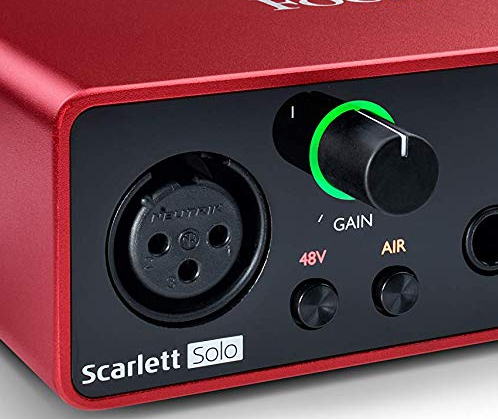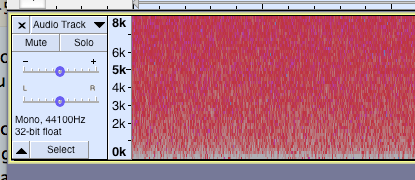I’ve converted my closet into a low budget recording studio to make an audiobook of my first (and hopefully subsequent) novel(s). I have a Zingyou ZY-007 with a spider mount and pop filter and a Focusrite Scarlett Solo. The Zingyou is said to have a signal to noise ratio of 78 dB. However, my recordings are landing just outside of the accepted levels. I can get RMS just over -23 or noise floor just below -60, but never both at the same time. And I can only do that much by speaking unnaturally loud.
I have found that I can meet ACX’s requirements by using Noise Reduction on my borderling shouty recordings. However, I’m wondering if there are any settings within Audacity that I can use to achieve this during the recording process. Something to effectively boost signal to noise, raising the RMS more than it increases the noise floor. Maybe make it so I don’t need to almost-shout?
Do you have the Solo all the way up? If you do, then that’s the limit. Audacity defaults to unity gain if it gets a digital signal, so the signal coming out of the Solo has to be correct.
Can you get the Solo knob to flash green while you’re recording? Scarlett considers that natural and normal volume for recording.

As an experiment, can you make the knob turn red? Never blow into a microphone, but can you shout loud enough to flash a red knob? Warn the neighbors.
You should have the +48 button pushed and the AIR button off.
Home recording systems are usually made with low volume. Loud volume and high sensitivity can cause overload and sound damage in new user hands. Sometimes called Clipping, it sounds pretty bad and causes the user to send the microphone back.
Low volume on the other hand makes the user think it’s their fault, pretty much what you’re doing. Low volume makes it really hard to meet noise limits, which isn’t obvious until later.
ACX is waiting for you. They hate distractions such as funny sound caused by stiff noise reduction or shouting to make volume.
Where is the computer during all this and what is it? One of the curses of USB microphone systems is needing to use and be close to a noisy computer. Can you tell if the computer is on just by listening?
We can do some analysis for you on the forum. Create a 20 second sound test according to this recipe. Look down the blue links. They’re very short.
http://www.kozco.com/tech/audacity/TestClip/Record_A_Clip.html
Don’t shout. Announce normally, Don’t process anything and use many different words. Read the side of the milk carton.
“Catskill Farm Cows are very contented…”
Koz
I haven’t turned it all the way up, but when I got it up enough to exceed an RMS of -23 dB, I was exceeding a noise floor of -60 dB by even more, so I assumed I shouldn’t go any higher. I’ve gotten it flashing green and orange, don’t know about red though. I also had the +48 on and the Air button on, because it seemed to get me closer to where I needed to be. So, it sounds like I need to try Air off and the knob all the way up.
The laptop is behind and off to the side from the microphone. Fairly close, but it’s a directional mic (I triple-checked that it’s turned the right way), and the laptop runs fairly quiet. Even on dead air recordings, I couldn’t hear it. From what I’ve read of other people’s experiences, I think the biggest issue is internal noise generated by the condenser mic.
Later tonight, I’ll do that sound test with the gain all the way up and the air off. Thank you so much for your help.
I think the biggest issue is internal noise generated by the condenser mic.
If they both go up when you make that adjustment, then yes, the microphone is making its own noise and you reached the limit—or—you’re amplifying the computer or environment noises.
There is a little amplifier in the microphphone. That’s what the +48 volts is running. When your voice hits the round element behind the grill, it does make a very high quality sound signal, but it doesn’t have enough zot to go down a cable. The amplifier increases the power (usually not the loudness) for the trip. It lowers the impedance, if you’re counting. On its own, the sound element has all the brute horsepower of a comb picking up a piece of lint in the winter.
As near as I can tell, the AIR button distorts the voice to simulate older microphone designs. I have no idea how they do that, but it’s possible they use a separate amplifier—and even more noise.
If you like the presentation generally, there are ways to suppress noise and it’s not just Noise Reduction.
Shoot a short sound test and publish on the forum. We can see if there’s anything to be done. Post it raw, no corrections and use many different words. Read the side of the cereal box.
http://www.kozco.com/tech/audacity/TestClip/Record_A_Clip.html
Go down the blue links. They’re very short.
Koz
I sense from your post that you’re not using Audiobook Mastering.
https://wiki.audacityteam.org/wiki/Audiobook_Mastering
The mastering tools guarantee RMS (loudness) and Peak. The only other variable (besides your voice) is noise. That gives you one thing to fix instead of chasing all three standards at once.
ACX Check is the tool we designed to simulate the first pass quality control robot at ACX. If you can pass all that, then your only hurdle is voice quality and ACX Human Quality Control.
Koz
I followed the instructions on the Record A Clip page, but even when I cut it below 15 seconds, I still got an error message saying the file was too large.
However!
I applied Audiobook Mastering, and hit RMS and Peak level just as promised. Noise Floor was between -53 and -54. I applied Noise Reduction of the Beast. Not quite there. Undo. Bumped it up to 8-6-6. Nailed it! And that was with Air off and the gain knob all the way up. Thank you!
Now, I just need to work on mouth noises and shift my recording spot a few inches to the left, so I’m not elbowing a bunch of hanging shirts. But that stuff is all on me.
-53 and -54.
What does it sound like? Gentle rain in the trees shshshshshshsh, or is there some other sounds in there? Can you hear your computer fans?
Try the test recording again and stop it at 10 seconds. Since you’re this close, a simple change may let you use more gentle noise reduction. 9, 6, 6 is the trigger to change something in your recording environment rather than brute force patching it up in post production.
Koz
Wait. There’s an app for that.
Select some of the noise (the two seconds before the performance) and switch the timeline to Spectrogram View with the menu on the left of the timeline.
It should look even about like this. This is what electronic noise looks like.

If you have streaks and lumps and bumps in it, that’s probably motor noise or some other interference.
Koz
Oh, and you’re not just outside the ACX requirements. Comfortable submission noise values hover in the -65dB range and yours comes in at -53dB. That’s 12dB difference. Sound goes half or double every 6dB. So you should reduce your noise volume by half…twice.
I shot a sound test with a little Zoom stand-alone reorder in my dead quiet (except for the Metrobus) bedroom. I transferred the work to my Mac and applied Audiobook Mastering. It meets noise value at -66dB with no noise reduction.
Koz